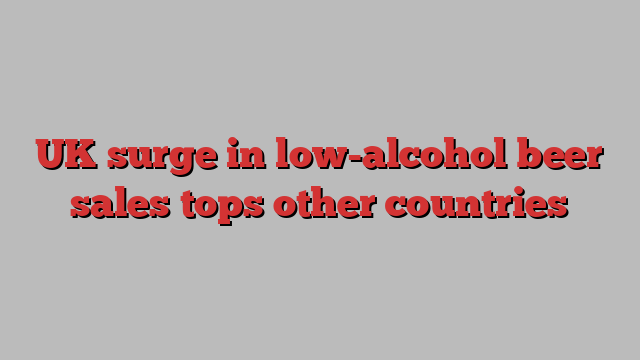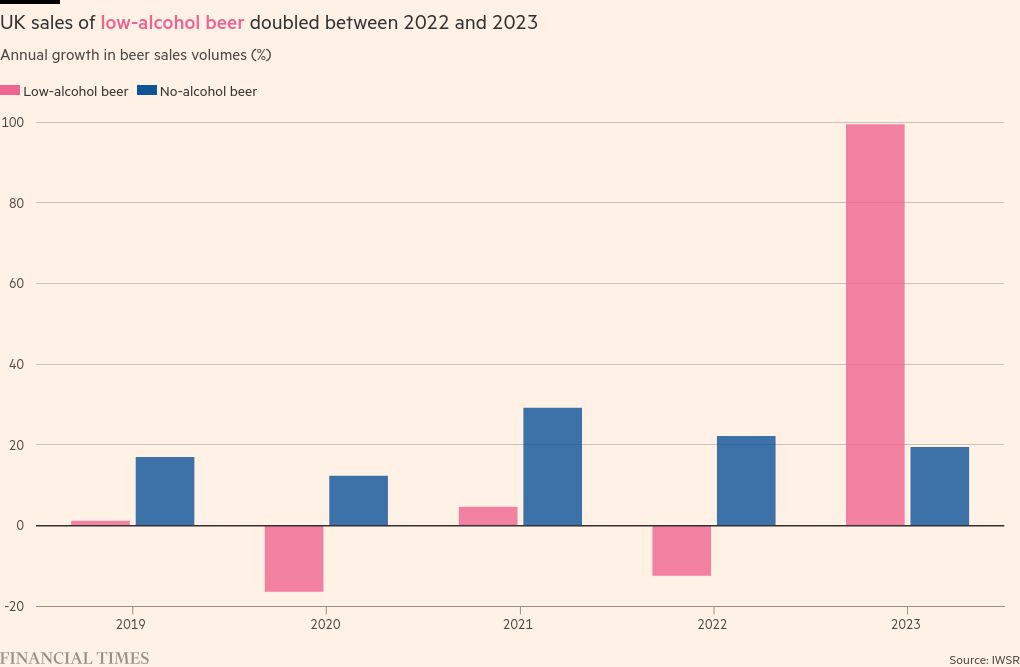
Unlock the Editor’s Digest for free
Roula Khalaf, Editor of the FT, selects her favourite stories in this weekly newsletter.
UK sales of low-alcohol beer increased more than in any other market in 2023 thanks to a post-Brexit overhaul of alcohol duties, as brewers took advantage of lower rates by launching new or revamped products.
Sales of low-strength beer with less than 3.5 per cent alcohol by volume doubled from 650,000 hectolitres in 2022 to close to 1.3mn hectolitres in 2023 after years of flat or declining performance, according to data provider IWSR.
The UK market for low-alcohol beer expanded more than any other in volume terms, growing twice as much as the next-highest country, Venezuela, where sales increased by 325,000 hectolitres last year. Romania and Japan were ranked joint third in the survey of 160 countries.
The UK is now the eighth-largest global market for sales in this category of drink, up from 13th in 2022, IWSR told the Financial Times.
Demand for low-alcohol or alcohol-free beer has soared in recent years. The world’s largest brewers, such as Guinness and Heineken, have all launched zero-alcohol alternatives of their big brands in response to the growing trend for moderation among health-conscious consumers.
Analysts said the low-alcohol beer market had taken off largely because of the post-Brexit changes to the alcohol duty system introduced last August, which mean products with less than 3.5 per cent ABV are taxed at a lower rate than stronger drinks.
Under the new system, brewers must pay £21.01 a litre of alcohol between 3.5 per cent and 8.5 per cent ABV, while beers below this threshold are charged £9.27 a litre. There are no duties on products below 1.2 per cent ABV.
IWSR senior market analyst Patrick Fisher said the UK had the largest-growing low-alcohol beer market largely owing to brand owners reformulating existing brands to take them below the 3.5 per cent ABV threshold. Some sellers have also launched fresh lower-strength products.
“Growth rates for the category are expected to normalise in the years ahead,” he added, with sales volumes of low-alcohol beer forecast to remain broadly flat between 2024 and 2028.

A number of products have been reformulated in response to the change, including Carlsberg’s Danish Pilsner and John Smith’s Extra Smooth bitter. BrewDog, the UK’s biggest craft brewer, launched a 3.4 per cent ABV lager called Cold Beer earlier this year.
The British Beer and Pub Association said brewers had “enthusiastically responded” to changing consumer tastes.
“Duty freezes and cuts and certainty around these gives brewers the confidence and ability to innovate and invest in low-strength and alcohol-free products,” it added.
Weaker beers are surging in popularity as consumers look for ways to avoid drinking excessively when socialising and be able to drive home, with 39 per cent of those aged 18-24 not drinking alcohol at all, according to YouGov polling data.
Meanwhile, the share of pubs serving on-draught “no- and low-” options has risen fourfold since 2019, BBPA research showed.
Meanwhile, UK alcohol consumption declined 2 per cent last year, according to IWSR.
Lucky Saint, the UK’s largest dedicated alcohol-free brand, said its products, once reserved for drivers, midweek drinkers and Dry January, were now bought consistently throughout the week and year round.
“We’re seeing the rise of ‘zebra striping’, this practice of people alternating between alcoholic and alcohol-free drinks within a single visit to the pub,” said Luke Boase, Lucky Saint’s founder.